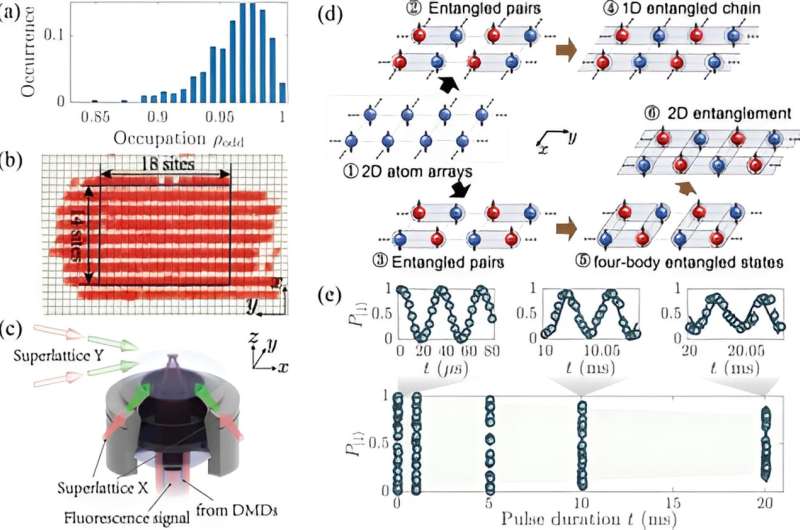This article has been reviewed according to Science X's editorial process and policies. Editors have highlighted the following attributes while ensuring the content's credibility:
fact-checked
peer-reviewed publication
proofread
Scalable multipartite entanglement achieved with ultracold atoms in optical lattice

Researchers from the University of Science and Technology of China (USTC) of the Chinese Academy of Sciences (CAS), in collaboration with researchers from Tsinghua University, led by Ma Xiongfeng, and Fudan University, led by Zhou You, have achieved significant advancements in the preparation and measurement of scalable multipartite entangled states.
Using ultra-cold atoms trapped in optical lattices, the research team successfully prepared multi-atom entangled states by creating a two-dimensional atomic array, generating entangled atom qubit pairs, and sequentially connecting these entangled pairs. Their work is published in Physical Review Letters.
The American Physical Society also highlighted this achievement with a feature in Physics Magazine titled "Milestone for Optical-Lattice Quantum Computer."
Quantum entanglement is fundamental phenomenon underlying quantum computing, the capabilities of which grow exponentially with the increase in the number of entangled qubits. Therefore, the preparation, measurement and coherent manipulation of large-scale entangled states are central challenges in the field of quantum research.
Among the physical systems used to implement quantum bits (qubits), ultracold atomic qubits in optical lattices exhibit excellent coherence, scalability and high-precision quantum control, which position them as an ideal choice for carrying out quantum information processing.
Since 2010, the USTC research team has systematically studied multibody phase transitions, atomic interactions and entropy distribution dynamics in optical lattices.
By 2020, the team achieved an entanglement fidelity of 99.3% with over 1,000 pairs of entangled atoms. These studies have paved the way for enhancing the fidelity of atomic entanglement and the capability of parallel atomic control, laying the foundation for larger multi-atom entangled states and further quantum computing research. However, previous efforts faced bottlenecks due to the limited ability to control individual atomic qubits, significant phase shifts in optical lattices, and a lack of effective methods for detecting and controlling multi-atom entanglement states.
To overcome these technical challenges, the team led by Pan Jianwei and Yuan Zhensheng developed a new equal-arm, cross-beam interference and spin-dependent superlattice system. They integrated self-developed single-lattice resolution, wide-band achromatic quantum gas microscopy and multiple sets of digital micromirrors for spot shape editing. This setup allowed for both multi-atom global parallel and local single grid point measurement and control.
With this, they achieved a 99.2% filling rate of a two-dimensional atomic array and prepared entangled Bell states with an average fidelity of 95.6% and a lifespan of 2.2 seconds. Furthermore, they connected adjacent entangled pairs to prepare a 10-atom one-dimensional entangled chain and an eight-atom two-dimensional entangled block.
This work marks a significant step toward large-scale quantum computation and simulation using optical lattices.
More information: Wei-Yong Zhang et al, Scalable Multipartite Entanglement Created by Spin Exchange in an Optical Lattice, Physical Review Letters (2023). DOI: 10.1103/PhysRevLett.131.073401
Journal information: Physical Review Letters
Provided by University of Science and Technology of China





















